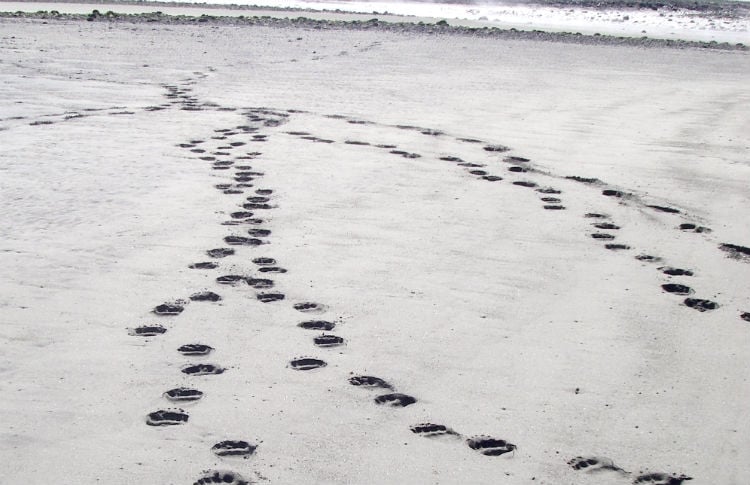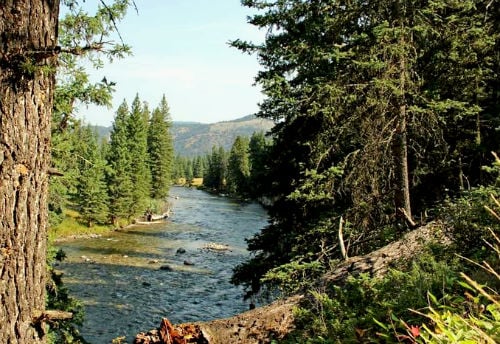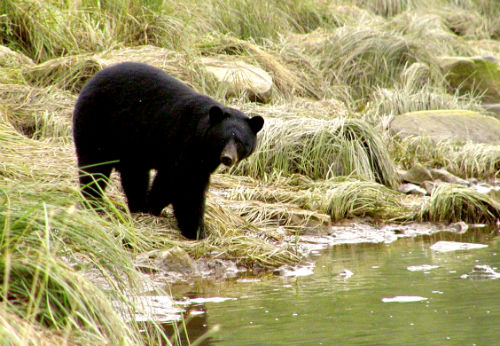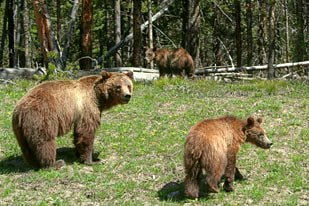
Hikers, campers, and nature lovers should enjoy the outdoors with caution – no matter where you are and what you are doing. Photo courtesy of NPS
When Brad Treat of West Glacier, Montana, went mountain biking with a family member in late June 2016, a leisurely ride turned into a real life nightmare when he was killed by a Grizzly. According to reports by the Montana Fish, Wildlife and Parks (FWP), Treat was cycling just outside of Glacier National Park when he startled the roaming bear. Park authorities believe that Treat collided with the Grizzly, which then mauled him. The other cyclist escaped and went for help. When they returned to the area, Treat was found dead.

While very infrequent, bear attacks occur usually when you least expect it. Photo courtesy of irv2.com
According to FWP officials: Sight visibility at the location of the collision is very limited and the collision was unavoidable. The bear reacted which led to the attack.
While Grizzly bear attacks are considered rare in the Glacier National Park area – or other regions for that matter across North America – they obviously do happen. Hikers, campers, and nature lovers should enjoy the outdoors with caution – no matter where you are and what you are doing.
For instance, a week prior to the tragic event involving Brad Treat, a sub-adult grizzly bear charged vehicles and proceeded to chase visitors in Denali National Park, along the Denali Park Road. Soon after, the same bear approached and charged several hikers on the Savage Alpine Trail. Fortunately, there were no injuries. Like Treat, however, those who have encountered bears in other circumstances weren’t so lucky.

Stay alert in various areas you are exploring. Photo courtesy of NPS.
In July 2011, a couple was hiking along the Wapiti Lake Trailhead in Yellowstone National Park. They stopped to quietly observe a female Grizzly and her cubs at what they thought to be a safe distance. After taking a few photographs and the bear realizing their presence, they left and continued on their hike. Soon after, they encountered the same bear, which began to chase the couple, causing them to run down the trail while making noise. The bear finally caught up with them and mauled the husband to death. His wife suffered no injuries.
Two years later in Denali National Park, a San Diego man who was hiking solo along the Toklat River was attacked and killed by a large Grizzly bear. The attack was reported when three day hikers discovered the remains of his gear and signs of a struggle. Park authorities learned that the attack occurred at the river’s edge and the bear dragged the remains of the man to a secluded site. Upon discovering his digital camera, park authorities reported that the man had taken images of the bear at a distance of 75 yards while it was feeding on wild berries. The last five images were of the bear with his head up, followed by consecutive shots of the Grizzly moving towards him. According to park authorities, the final images were taken at a distance of 60 yards.
Bear attacks – no matter what type of species – are not isolated to the wilderness or the heavily bear-populated Northwest.

Grizzly bears in Yellowstone National Park.
In fact, in June 2011, The Arizona Game and Fish Department reported that a 61 year-old woman was out walking her dog in the suburbs of Pinetop-Lakeside, AZ, when she was attacked by 250-pound black bear near a neighborhood dumpster. The bear reportedly brutally mauled the woman three separate times before residents scared the bear away. Paramedics were called and the woman – who suffered life-threatening injuries – was air-lifted to a Phoenix trauma center. After undergoing surgery numerous times, she died four weeks later from a massive brain hemorrhage due to the attack.
While very infrequent, bear attacks – whether it’s a grizzly, black or other species – occur usually when hikers, cyclists, anglers or anyone who enjoys the outdoors least expect it and should take measures in the event that an attack can happen.
Quick Facts about Bear (and Grizzly) Attacks
A report by the National Park Service revealed that in Yellowstone National Park alone:
- Nearly 100 million people visited the park between 1980 and 2014 and during that time 45 people were injured by bears in the park.
- During that 34 year period, 34 human injuries were caused by Grizzly bears in the backcountry, an average of one per year.
- From 1980-2014, there have been only two grizzly bear-caused human injuries in developed areas, an average of approximately 1 every 18 years.
- The chances of being attacked by a bear are approximately one in 2.2 million.
- The chances of bear attacks are much higher for those hiking in backcountry areas.
- Injuries caused by black bears have decreased from an average of 46 per year from 1931- 1969, to four per year during the 1970s.
Finally, according to the Wildlife Society, “At least 63 people were killed in 59 incidents by non-captive black bears during 1900–2009. The fatal black bear attacks occurred in Canada, Alaska and in the lower 48 states.” The society also reported that “of the fatal attacks, 91percent (49 of 54) occurred in parties of one or two people and 38 percent (15 of 40) of incidents, involved food or garbage probably influenced the bear to attack.”

Update to this story. Brad Treat was an officer with the US Forestry Service and was on a mountain bike riding trails with a friend when this bear attack occurred. He was only 30 with a young family. It was a very unfortunate event but Glacier Park officials did track the attacking bear and put it down.
This was listed in all the Montana local news papers and media.
And yet another reason to carry. My prayers go out to this mans family. A handgun may not stop a grizzly, but at least you have something better than your hands. FYI, I am a legal gun owner, with a carry permit.
If the bear went to your neighborhood he would have been put down too.
But you are in his neighborhood, and must be respectful of their neighborhood rules.
I have seen these bikes racing threw the trails, and they can come up very fast on any animal.
Rabbits will run, if you crash into a bear, he won’t put up with it.
Sorry for the family, but he should have known better.
Hi, Jim, as you know, a 44 magnum stops bears fairly well with a decent shot.. Last resort, though, you never want to be that close. No confidence in anything less. The “bear spray” is over-rated.
100% agree
Yep I always Carry. And it is good to know the laws in National Parks and or Monuments with regard to your State Laws, So you do not have to be helpless. There are dangers out there from 4 legged animals.
Remember the most dangerous animals are humans……being attacked by an already known possibly dangerous animal is not anyone’s fault….just bad decisions or bad timing. RIP to all that were killed in this manner.
I was afraid of hiking in bear country when I moved to Montana 16+ years ago. So I read everything I could find on bear. In all of my reading, I found that in 95+% of the attacks, the human did something stupid; the rest were unfortunate happenstance. There are two general rules:
* Don’t approach bear cubs; momma won’t like that.
* Don’t approach a feeding bear; animals fight for food.
* If you stumble onto a bear, do not run away. It triggers their prey instinct.
The best thing to do if you are hiking quietly in bear country is to see the animals before they see you. You might call it situational awareness, but hunters consider it an important skill.
I enjoy seeing the wild beasts. Fortunately, I’ve had only one serious bear encounter.
It can be a little intimidating out there for those new to hiking and camping, but thanks for your insight.
Never be afraid, always be prepared….
First off, I feel for all of the families on these tragedies.. But PPlllease… He ran into the bear with his mountain bike…. Others were noted as bothering the bears as well… Observe FROM A DISTANCE and you won’t have these things happening.. Consider this.. 60 yards = 90 feet which is about the size of most city lots. Do you think watching a momma black bear or any bear that is within distance of your yard or standing in your neighbours yard SAFE distance??? I don’t think so.
Ahh, 60 yards is 180 feet.
To Richard, 60 yards would be 180 feet, oversight I’ve done as well.
Check the story of the 61 year old ex-boxer and bear hunter. Recently walking his dog by a small town in Alaska, cub startles him coming from a bush and bawls. Here comes 300 lbs of mama. He grazed the bear with a punch, The bear cut him in the face and arm. Saying bears are right-handed, he dodged another swipe and nailed the bear in the nose hard as he could. With nose bleeding, the bear decided to follow her cub scampering to the woods. He was lucky.
The best advice is don’t get close and don’t stand there and watch them unless inside a vehicle.
That must have been a black bear. Brown bears (AKA grizzly bears) would have killed him for fighting back.
BTW, we are in Alaska, for the summer, this year, and loving it!
At several places, including Denali National Park, we have been advised that the grizzly bear is no longer considered a separate sub-species of the brown bear because their DNA cannot be differentiated from the brown bear. The only remaining sub-species of the brown bear is the Kodiak bear. The DNA of the Kodiak, which live on Kodiak island, is different than the brown bear.
My observations on this subject are that you should carry bear spray whenever going out into bear country; but, that human beings are still the superior species and it was right that the bear that killed this young man was “put down” (killed) so it would not go after other human beings. Going armed, where permitted, with a firearm of sufficient power would absolutely be advisable, and might have saved this man’s life…
Uh, 60 yards = 180 feet, but point still valid. Give all bears a wide berth!
God grant the family Grace and strength to get through this tragic loss. No one can understand these things. Mr Treat happened to be in the wrong place at the wrong time.
I read in another story he had collided with the bear. May be info from the companion rider. I won’t be hiking any back country trails in bear country, for sure. Honest, law-abiding people can’t carry a weapon since the Park Service posts “no guns”.
It`s absolutely advisable to realize the regulations and laws of the use of firearms in certain parks, regions and States, which should be practiced with the utmost safety and responsibility.
If you haven`t already, check out this recent article on rvlife.com
http://rvlife.com/best-weapon-survive-bear-attack/
In the 80’s in Alaska, I had a customer come into the shop who had a remote cabin. He had 2 cases of bear spray under the porch which the grizzly punctured! Everyone of the cans had been bitten by that bear…
I do not believe that bear spray study, and certainly would not bet my life on it. Some bear viewing guides, in salmon country, use extremely bright flares, which they claim are a sufficient deterrent. Still, I prefer to put my faith in the brain and back it up with a 20/12 gauge with slugs. Ya, you still might get attacked and seriously injured. The Forest Service in Alaska still carry .375 H H or 12 gauge shotgun, or a 45-70 Marlin Guide gun, (lever action rifle), just in case…
Our thoughts are with the young family of the Park Service employee who lost his life to the bear….. and the bear lost her life as result….. Definitely not a win/win.
Yes, the Park Service forbids fire arms……I was thinking the same thing as you….. While a gun might make some people feel safer….I think it might embolden others and possibly cause them to perhaps create more bear attacks by pushing those invisible boundaries a bit further? Some feel safer when armed and ultimately take risks they might not otherwise take? Allowing a park full of firearms is not the answer. The animals need their space just as we need ours. We have the ability to think freely and should already know that the bears have a reputation of fiercly protecting their young…… When in these areas….Take it easy and like many others have shared……play it safe and remain on guard at all times. Just pay attention to what’s going on around you….Act as if your life could be at risk….
We have been “full timers” going on our 8th season now. We try to be a good neighbor and always treat our came site as if we were deep in the heart of the woods with wild animals all over the place. After all, it is a National Forest We follow all Park Rules pertaining to food storage and not leaving anything laying about that might lure a hungry bear into our camp.
In Moraine Camp Ground inside of Yellowstone, near Estes Park Colorado, we had a neighbor from another country camping next to us. WE could see them the evening before and I don’t recall seeing a tent….perhaps they slept in their car? I could see they left a big skillet with lots of chili & beans stuck to the insides of this skillet. The nearest water was at the entrance of the camping area next to the Rangers Office. Perhaps they did not want to bother with cleaning the skillet of forgot to pick up their belongings before leaving? Hard to say? They had left food bags, cookies and other items of interest to a hungry bear laying all over the area and this was all within 30 feet of our camp site. Everything but the camera they left on the table indicated they had left camp early that morning and were not coming back. I asked a Park Ranger if it would be considered trespassing if I was to clean up the site beside us considering the risk of a bear entering camp. We removed all offending articles and the Ranger confiscated their skillet….. WE did leave the camera where it was laying in case they came back looking for it….. WE never saw them again and I left the camera laying there when we left the next day! I’m not sure if they ever returned to claim their things or not….They had gone off and left everything laying there without any kind of concern for others or perhaps an emergency arose? It was a mystery for sure.
WE all must do our parts to make sure the Camping Areas remain as safe as we can help make them…..Use the food lockers, be careful about storing your grill with lots of fresh grease sticking to the grate and bottom of the grill. I always raise the flame after cooking and try to burn off excess grease and never allow it to build up. That’s enough meat grease & scent of cooked meat to bring hungry bear and other hunters in to your camp site. Be a responsible camper and think ahead when you can…….. Thank You….mike & judy, Louisville, KY
Firearms are now permitted in National Parks if you are in compliance with state law. They are not permitted in Federal Buildings including national parks.
Firearms are, indeed, legal to carry in Glacier National Park (http://www.glacier-national-park-travel-guide.com/glacier-national-park-gun-laws.html) since legislation was passed and signed under the Obama administration. With that said, bear spray is probably the most effective way to survive a bear attack.
1960, waiting in traffice at the west entrance to Yosemite park, a bear crawled into a window of the stationwagon ahead of our car. No fear. People bailed right and left. Within seconds, the inside of their car was ruined.
What to do if a bear attacks? Kill it and eat it.
It is my understanding that no charging grizzly attack has ever been stopped by a handgun, regardless of caliber. Bear spray is documented to have stopped many a charge.
Not the case— A few years ago it was reported in the mainstream news that a hiker killed a ( charging ? ) grizzly in Alaska somewhere with 9 shots from a .45 caliber semi- auto pistol. Didn’t give the gun brand or the shooter’s description. Probably a veteran who knew how to handle the wicked .45.
Thanks alot Roy….Interesting thank you for the update. I am considering going full time RV’ing and want so spend alot of time in national parks admittedly stories very much scare me.
Just to clear things up… Brad was a Forest Service Law Enforcement Officer, not Park Service. He was 38 years old and left behind a loving wife but no kids. The bear that was responsible for the attack was not found and the efforts to trap it were called off a few days after the attack. Brad grew up in this valley and was a short distance from his own house. He was about as woods wise and one can get and this was definitely a freak accident. The park service dose not forbid firearms. It is perfectly legal to carry firearms in any of our national parks. Discharging them is another story but in defense of life I would advise you pull the trigger. Brad was a coworker of mine and I live in the valley. Just wanted everyone to have the facts.
Hi MarcE,
Thanks for the updates and we are sorry to hear about the loss of your co-worker.
It appears I am one of the few hunters and lifelong outdoor sportsman in this entire reply. Yes I eat what I kill.
Are none of you reading the original story? This was a “blind curve.” There was “no visibility”! Please cease with blaming this young man for running his bike into a bear and that he should have “Know Better”.
The individual Who says being armed is a false sense of security and results in approaching danger closer I can readily see has zero experience with fire arms and Nor does he understand the Fire arms educational and family background of those of we that carry them! We are actually trying to avoid such confrontation. But to be there as necessarily when called upon
The”Poor bear” moaners thinley veiled claims of ‘my heart goes out to the family, BUT’ This bear PC stuff ……y’all need to STOPwith! No, bears do not have rights also. Bears are dumb animals. No dumb animal on earth is worth this young man’s life, or even yours, They might be God’s creature they. Or not created in our lords image! He was. In fact their original purpose was to be near the top of our food chain.
Amen, Brother…